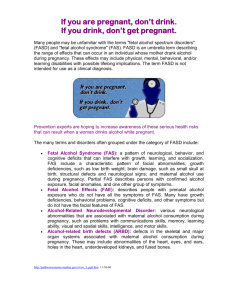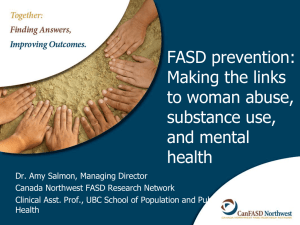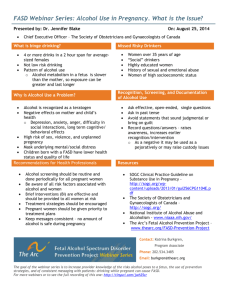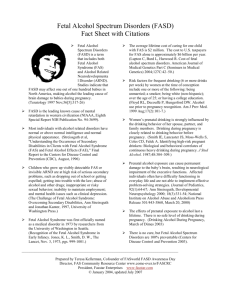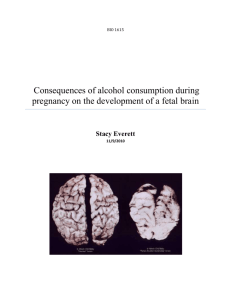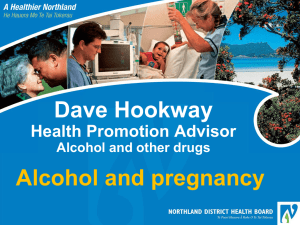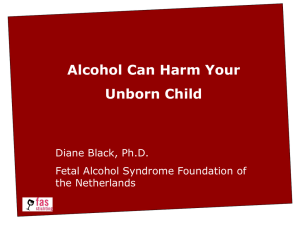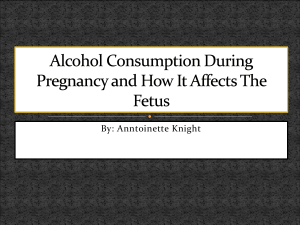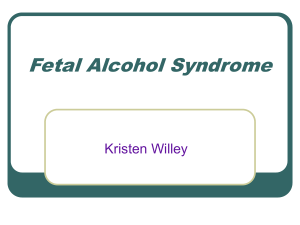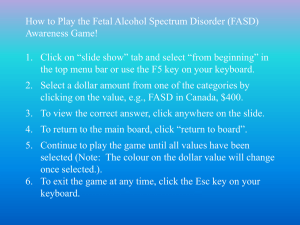Dr Moira Plant - Faculty of Life and Health Sciences
advertisement
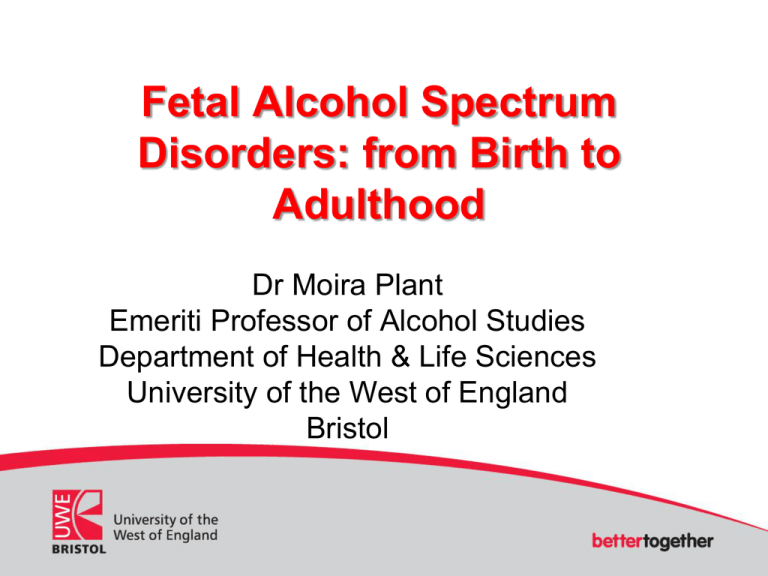
Fetal Alcohol Spectrum Disorders: from Birth to Adulthood Dr Moira Plant Emeriti Professor of Alcohol Studies Department of Health & Life Sciences University of the West of England Bristol • • • • Diagnostic paradigms Features at different ages Maternal Issues Should we be concerned? Diagnostic Paradigms • 1973 Fetal Alcohol Syndrome – Pre and post natal growth deficiency – Physical anomalies » distinctive facial features – Central nervous system dysfunction » Severe learning/living difficulties – “Identifiable” drinking problem in mother • 1973 Fetal Alcohol Effects Diagnostic Paradigms: Fetal Alcohol Spectrum Disorders (FASD) 2002 1) 2) 3) 4) Growth Facial features Brain Maternal Drinking History FAS FACIAL FEATURES FAS Diagnostic Guide and CD-ROM Fetal Alcohol Spectrum Disorders • FASD is an umbrella term which covers the range of harms. • It is NOT a diagnosis. • Other terms now in use • Alcohol related neurodevelopmental disorders (ARND) • Alcohol related Behavioural Disorders (ARBD) Some of the Confusion • More recently alcohol-related foetal harm is being seen mainly in terms of brain damage. • The facial features are being almost downgraded in terms of their importance. • This is mainly because the facial features are only present if alcohol is consumed in higher doses in the first trimester. Even More Confusion! • Not all children with alcohol related harm have low IQ. • We do not know how much alcohol causes what severity of harm. • People use the terms FAS and FASD interchangeably. • Different organisations use different advice eg Royal Colleges, NICE, Depts of Health Prevalence of FAS • • • • • • • Range from 1 per 1,000 low risk populations (US). 4 per 1000 in moderate risk populations, 39.2 per 1000 in (high risk) (May, 2001) South Africa 40+ per 1000 (very high risk) ( Molteno, 2008). Southern Australia to be 0.18 per 1,000 (O’Leary 2002) Indigenous communities 1 in 170 live births (Golden, 2005). UK we don’t know - drinking pattern vary between countries • In France and Germany 1 in 330, Sweden 1 in 600 (Blackburn et al 2009) Simple View of Causation An individual child’s risks of FASD are influenced by; • Quantity of alcohol consumed by mother during pregnancy. • Pattern of alcohol consumption. • Frequency (how often) the mother drinks. • Timing of drinking in relation to period of gestation. Critical Periods of Human Development Moore et al 1988 Anti-depressants in Pregnancy • Study of 673,853 Danish women - 35,737 had a diagnosis of depression and/or used SSRIs before the end of pregnancy women; – Use of anti-depressants during pregnancy slightly increases the rate of Small for Gestational Age (SGA) – Use of anti-depressants associated with increased low Apgar scores Jensen et al (2013) Additional Factors • “In the US, the vast majority of postpartum women with depression are not identified or treated even though they are at higher risk for psychiatric disorders--- A woman’s mental health has a profound effect on fetal development as well as her child’s physical and emotional development.” Wisner et al 2013 Birth to 36 months • May have been diagnosed as “failure to thrive” (one of many diagnoses given over time). • Difficulties with feeding. • Difficulties in establishing a regular sleeping pattern. • Irritability very active/hyperactive. • Frequent bouts of illness. • Delay in reaching milestones. • Indiscriminate, people are interchangeable. FAS/FAE Support Network Vancouver Alcohol and Breast Feeding • Breast-fed infants experience significantly less active sleep after exposure to alcohol in their mothers’ milk than do breast-fed infants not exposed to alcohol. • Compensatory increases in active sleep were then observed in the next 20.5 h, when mothers refrained from drinking alcohol. Mennella et al 1991, 1997, 2001 Alcohol and Breast Feeding • No difference in the caloric content of mother’s milk. BUT • Infants consume significantly less milk during the 4 hour period immediately after exposure to alcohol in mothers’ milk compared to controls. • Compensatory increases in intake can be observed during the 8 – 16 hours after exposure when mothers refrained from drinking. Mennella J (2001) Alcohol and Breast Feeding • Significant differences in motor development at one year of age in those babies subjected regularly to alcohol through breast milk. National Institute of Child Health and Human Development Koren, G 2002 Motherisk Programme Failure to grasp cause and effect? Three to Five Years • • • • • • • Easily overwhelmed. Frequent lengthy temper tantrums. May be physically aggressive. Reacts badly to and resists change. Unable to learn from experience. Accident prone. Fearless/unable to comprehend danger. FAS/FAE Support Network Vancouver Jason 4 Years old Adam Six to Ten •Short in Height/Light in Weight. •No “Catch up” Growth. •Difficulty in grasping the concept of cause and effect. FAS/FAE Support Network Vancouver Adam Six to Ten •Visual memory better than auditory memory. •Information seems to “slip in and out” Remembers today, forgets tomorrow and remembers again next week. Interpreted by teachers? •Difficulty separating fact from fantasy. FAS/FAE Support Network Vancouver Ten to Fourteen • Initially may be seen as intelligent based on language skills. • Lots of words but quantity masks quality. • Speech problems e.g. stammering. • Gets lost quickly in conversation and loses interest. • Trouble following directions. • Little understanding of social norms. • Increased risk of drink/drug use. FAS/FAE Support Network Vancouver Fourteen to Eighteen • No sense of personal space or boundaries. • May be sexually inappropriate/does not understand risks. • Overly affectionate with people s/he does not know well. • May be teased or bullied by other adolescents. • May bully or frighten others. • Moves through extremes of behaviour in a short space of time. • May be diagnosed as “Conduct Disorder“. • Burns people out. FAS/FAE Support Network Vancouver Adult • Judgement and critical thinking are poor • Lacks social skills either aggressive or withdrawn • Blames others for own mistakes • Involved in criminal activity • Difficulty in keeping job • Abusive relationships • Mental health problems Counselling ?useful » Depressed/ suicide attempts » Anxious FAS/FAE Support Network Vancouver Changes with Age • Facial features become less obvious • Developmental changes may be negative. IQ may decrease by up to 15 points between early childhood and adolescence. Steinhausen et al 1994 CJ 8 Years 18 years 22 years Younger V Older Younger/Teenage • • • • Later recognition of pregnancy due to irregular periods, not wanting to accept the fact so later attendance at ante-natal clinics In Bristol 84% of mothers under 20 years of age reported having unplanned pregnancies. Will continue to drink at prepregnancy levels further into their pregnancy Lower weight gain; maternal body at a stage when it needs more nutrients for own growth and development so potential competition for nutrients • Older Longer drinking history Increased risk of liver damage if drinking heavily May be aware of being pregnant earlier in pregnancy IF they have been pregnant before. Younger V Older – May be reduced flow of nutrients to the foetus due to immature placental development – Many teenagers do not see a problem in continuing to eat fast foods with the high sugar and fat content – Eating disorders associated with higher risks if neural tube defects, miscarriage, low birth weight and post partum depression – Psychiatric illness (mood, anxiety, thought disorders) – The fear of having children taken away will prevent women with drinking problems seeking help early. – Chaotic lifestyle (living with a problem drinker). – Poor nutrition (GI problems, poverty). – Poly-drug use • You cannot ignore the fact that this is a dyad (triad?) CSA • The guilt and shame problem drinking women feel is greater than we can understand. • The fear of having children taken away will prevent women with drinking problems seeking help early. UK Review of the evidence • “In summary, for most outcomes there was no consistent evidence of adverse effects from lowmoderate alcohol consumption (1.5 UK units daily). • “There was some evidence of adverse effects on neurodevelopment of binge drinking in pregnancy”. Gray and Henderson 2006 Why should we be concerned? • Because families are being blamed for their children’s behaviour and other issues. “Nothing the birth mother could have done would account for this. You are just not feeding him enough” • Because children are failing in school through not being diagnosed with FASD and getting help. • Because it is possible/probable that there are people in UK prisons who are there because they cannot tell right from wrong and don’t understand cause and effect due to their FASD. Why should we be concerned? • Because the vast majority of people affected by FASD are not children but adults. • Because the cost to the National Health Service has not yet been measured but when it is-------! Why should we be concerned? •Because it is preventable! The Ideal • FASD is understood to be a lifetime condition. • Access for initial diagnosis should be available at any time in life that the question of FASD is raised. • Appropriate follow-up after diagnosis should be available for as long as necessary Sterling Clarren Personal Communication 2013 What should the Message be? • Don’t drink if you are pregnant. • If you are pregnant don’t drink. Unplanned Pregnancies • UK Study: 84% of mothers under 24 years of age reported having unplanned pregnancies. (Dex and Joshi 2005) • The majority of pregnant women continue a their pre-pregnancy drinking levels until pregnancy is confirmed. (Tough et al 2006) • Younger women will drink further in to their pregnancies than older women. What should the Message be? • Don’t drink if you are pregnant. • If you are pregnant don’t drink. • If you’re drinking don’t get pregnant. • If your drinking don’t get someone else pregnant.
